A little poem for congress, and people embroiled in conflict everywhere:
The Noble Art
The noble art of Losing Face
may one day save the Human Race
and turn into eternal merit
what weaker minds would call disgrace.Piet Hein
Business Insider has a nifty compilation of cognitive biases, extracted from wikipedia’s huge list.
It would be cool to identify the ones that involve dynamics, and identify a small conceptual model illustrating each one.
In SD, we often call these misperceptions of feedback, though one might also include failures to mentally simulate accumulation, which doesn’t require feedback. Some samples that jump to mind:
Drunker than intended: Misperceptions and information treatments
Capability traps and self-confirming attribution errors in the dynamics of process improvement
Modeling managerial behavior: Misperceptions of feedback in a dynamic decision making experiment
Bathtub dynamics: initial results of a systems thinking inventory
What’s your favorite foible?
At the Balaton meeting, I picked up a report on happiness in Japan, Measuring National Well-Being – Proposed Indicators. There’s a lot of interesting material in it, but a figure on page 14 stopped me in my tracks:
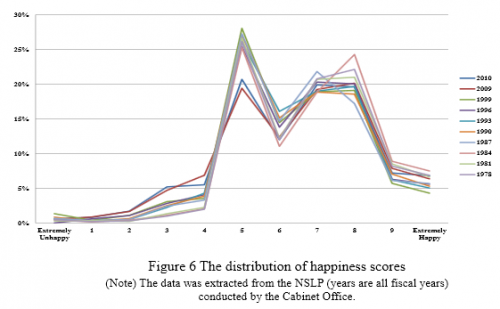 The distribution of happiness scores is rather strongly bimodal, and has been stable that way for 30+ years.
The distribution of happiness scores is rather strongly bimodal, and has been stable that way for 30+ years.
There might be an obvious explanation: heterogeneity – perhaps women are happy, and men aren’t, or the reverse, or maybe a lot of people just like to answer “5”. But the same thing appears in some European countries:
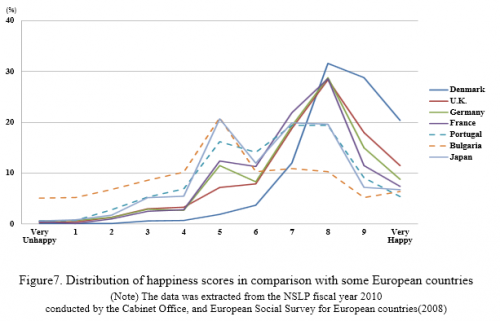 Denmark is obscenely happy (time to look for an apartment in Copenhagen) but several other countries display the same dual peaks as Japan. I wouldn’t expect the same cultural dynamics, so what’s going on?
Denmark is obscenely happy (time to look for an apartment in Copenhagen) but several other countries display the same dual peaks as Japan. I wouldn’t expect the same cultural dynamics, so what’s going on?
A tantalizing possibility is that this is the product of a dynamic system. But if so, it’s 1D representation would have to look something like,
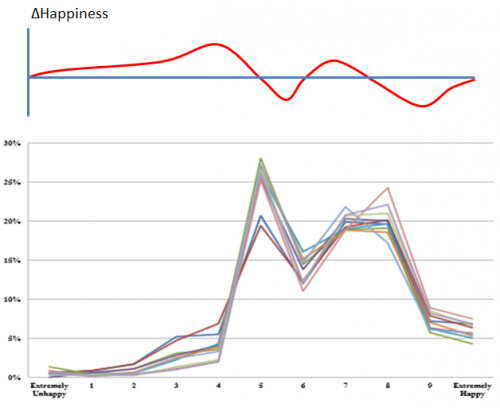 That’s really rather weird, so perhaps it’s just an artifact (after all, bimodality doesn’t appear everywhere). But since happiness is largely a social phenomenon, it’s certainly plausible that the intersection of several feedbacks yields this behavior.
That’s really rather weird, so perhaps it’s just an artifact (after all, bimodality doesn’t appear everywhere). But since happiness is largely a social phenomenon, it’s certainly plausible that the intersection of several feedbacks yields this behavior.
I find it rather remarkable that no one has noted this – at least, google scholar fails me on the notion of bimodal happiness or subjective well being. A similar phenomenon appears in text analysis of twitter and other media.
Any theories?
Replicated from
The Emergence of Environmental Homeostasis in Complex Ecosystems
The Earth, with its core-driven magnetic field, convective mantle, mobile lid tectonics, oceans of liquid water, dynamic climate and abundant life is arguably the most complex system in the known universe. This system has exhibited stability in the sense of, bar a number of notable exceptions, surface temperature remaining within the bounds required for liquid water and so a significant biosphere. Explanations for this range from anthropic principles in which the Earth was essentially lucky, to homeostatic Gaia in which the abiotic and biotic components of the Earth system self-organise into homeostatic states that are robust to a wide range of external perturbations. Here we present results from a conceptual model that demonstrates the emergence of homeostasis as a consequence of the feedback loop operating between life and its environment. Formulating the model in terms of Gaussian processes allows the development of novel computational methods in order to provide solutions. We find that the stability of this system will typically increase then remain constant with an increase in biological diversity and that the number of attractors within the phase space exponentially increases with the number of environmental variables while the probability of the system being in an attractor that lies within prescribed boundaries decreases approximately linearly. We argue that the cybernetic concept of rein control provides insights into how this model system, and potentially any system that is comprised of biological to environmental feedback loops, self-organises into homeostatic states.
See my related blog post for details.
An interesting article in PLOS one explores the consequences of a system of random feedbacks:
The Emergence of Environmental Homeostasis in Complex Ecosystems
The Earth, with its core-driven magnetic field, convective mantle, mobile lid tectonics, oceans of liquid water, dynamic climate and abundant life is arguably the most complex system in the known universe. This system has exhibited stability in the sense of, bar a number of notable exceptions, surface temperature remaining within the bounds required for liquid water and so a significant biosphere. Explanations for this range from anthropic principles in which the Earth was essentially lucky, to homeostatic Gaia in which the abiotic and biotic components of the Earth system self-organise into homeostatic states that are robust to a wide range of external perturbations. Here we present results from a conceptual model that demonstrates the emergence of homeostasis as a consequence of the feedback loop operating between life and its environment. Formulating the model in terms of Gaussian processes allows the development of novel computational methods in order to provide solutions. We find that the stability of this system will typically increase then remain constant with an increase in biological diversity and that the number of attractors within the phase space exponentially increases with the number of environmental variables while the probability of the system being in an attractor that lies within prescribed boundaries decreases approximately linearly. We argue that the cybernetic concept of rein control provides insights into how this model system, and potentially any system that is comprised of biological to environmental feedback loops, self-organises into homeostatic states.
To get a handle on how this works, I replicated the model (see my library).
The basic mechanism of the model is rein control, in which multiple unidirectional forces on a system act together to yield bidirectional feedback control. By analogy, the reins on a horse can only pull in one direction, but with a pair of reins, it’s possible to turn both left and right.
In the model, there’s a large random array of reins, consisting of biotic feedbacks that occur near a particular system state. In the simple one-dimensional case, when you add a bunch of these up, you get a 1D vector field that looks like this:
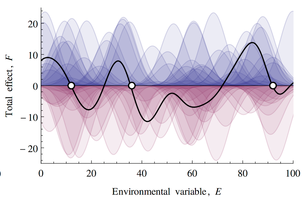 If this looks familiar, there’s a reason. What’s happening along the E dimension is a lot like what happens along the time dimension in pink noise: at any given point, the sum of a lot of random impulses yield a wiggly net response, with a characteristic scale yielded by the time constant (pink noise) or niche width of biotic components (rein control).
If this looks familiar, there’s a reason. What’s happening along the E dimension is a lot like what happens along the time dimension in pink noise: at any given point, the sum of a lot of random impulses yield a wiggly net response, with a characteristic scale yielded by the time constant (pink noise) or niche width of biotic components (rein control).
What this yields is an alternating series of unstable (tipping) points and stable equilibria. When the system is perturbed by some external force, the disturbance shifts the aggregate response, as below. Generally, a few stable points may disappear, but the large features of the landscape are preserved, so the system resists the disturbance.
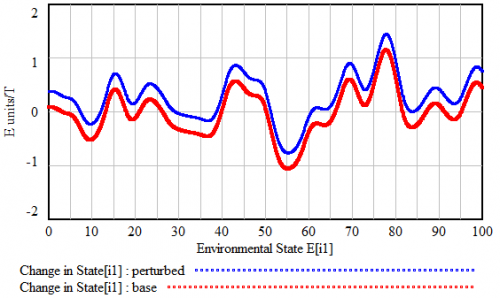 With a higher-dimensional environmental state, this creates convoluted basins of attraction:
With a higher-dimensional environmental state, this creates convoluted basins of attraction:
 This leads to a variety of conclusions about ecological stability, for which I encourage you to have a look at the full paper. It’s interesting to ponder the applicability and implications of this conceptual model for social systems.
This leads to a variety of conclusions about ecological stability, for which I encourage you to have a look at the full paper. It’s interesting to ponder the applicability and implications of this conceptual model for social systems.
While the government is shut down, it seems like a good time for a rousing round of Alan Atkisson‘s GDP Song:
The shutdown means GDP measurements are on ice, which is not all bad, though we can expect a 15 basis point drag on GDP per week to include some real harm.
 Shutting down our measurement systems strikes me as alarmingly close to turning off the instruments on the flight deck of a plane, due to a route dispute between the pilot and copilot.
Shutting down our measurement systems strikes me as alarmingly close to turning off the instruments on the flight deck of a plane, due to a route dispute between the pilot and copilot.
I’m reflecting on Deborah Rogers‘ presentation on equity/equality at the Balaton Group meeting, concerning the apparent evolutionary drivers of the transition from a long human prehistory of egalitarian societies to today’s extreme inequity. A key point of terminology is that equity and equality are not quite the same thing – equality implies similar wealth or resource access, while equity implies something more like Rawlsian justice. But you can’t have one without the other, because inequality leads the haves to tilt the tables of justice against the have-nots.
This might not be a deliberate choice to exploit the masses. It could occur as an evolutionary consequence of the inability to predict the outcome of dynamically complex decisions.
I once described a complex theory of the emergence of inequality to Donella Meadows. I no longer remember the details, but perhaps it was the ancestor of this. Her answer was characteristically simple and insightful, to the effect of, “it doesn’t matter what the specific dynamics are, because the rich control the decisions, so the question boils down to how much inequ(al)ity the elite will tolerate.”
Evidence indicates that high inequality is bad for growth, so a possible irony is that policies that transfer wealth to the wealthy in the short run are bad for them in the long run, because growth eventually dominates allocation, even for the richest.
So, for me, the key question for society is, how much positive feedback should a civilization build into its social organization?
A bit of positive feedback can be helpful, if it creates a gradient that guides individuals who aren’t making the best decisions to imitate the habits of their more successful peers.
However, this probably requires a relatively low level of inequality. As soon as there’s stronger positive feedback, it’s likely that dysfunctional feedbacks take hold, as the wealthiest institutions use their market power to block innovation and good governance in service of maintaining their exalted positions.
I think the evidence that this occurs today is probably fairly simple. Look at the distribution of IQs or any other metric that might be an input to productivity in the economy. It’ll be relatively Normal (Gaussian). But the distributions of wealth and power are heavy tailed (Zipf or Double Laplace). That’s a pretty clear indication that there’s a lot of reinforcing feedback at work.
After I wrote my last post, it occurred to me that perhaps I should cut Ellis some slack. I still don’t think most people who ponder limits think of them as fixed. But, as a kind of shorthand, we sometimes talk about them that way. Consider my slides from the latest SD conference, in which I reflected on World Dynamics,
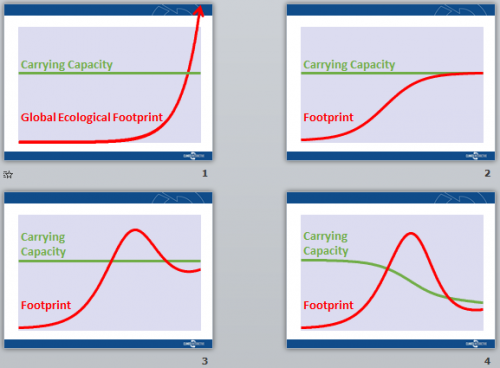 It would be easy to get the wrong impression here.
It would be easy to get the wrong impression here.
Of course, I was talking about World Dynamics, which doesn’t have an explicit technology stock – Forrester considered technology to be part of the capital accumulation process. That glosses over an important point, by fixing the ratios of economic activity to resource consumption and pollution. World3 shares this limitation, except in some specific technology experiments.
So, it’s really no wonder that, in 1973, it was hard to talk to economists, who were operating with exogenous technical progress (the Solow residual) and substitution along continuous production functions in mind.
Unlimited or exogenous technology doesn’t really make any more sense than no technology, so who’s right?
As I said last time, the answer boils down to whether technology proceeds faster than growth or not. That in turn depends on what you mean by “technology”. Narrowly, there’s fairly abundant evidence that the intensity (per capita or GDP) of use of a variety of materials is going down more slowly than growth. As a result, resource consumption (fossil fuels, metals, phosphorus, gravel, etc.) and persistent pollution (CO2, for example) are increasing steadily. By these metrics, sustainability requires a reversal in growth/tech trend magnitudes.
But taking a broad view of technology, including product scope expansions and lifestyle, what does that mean? The consequences of these material trends don’t matter if we can upload ourselves into computers or escape to space fast enough. Space doesn’t look very exponential yet, and I haven’t really seen credible singularity metrics. This is really the problem with the Marchetti paper that Ellis links, describing a global carrying capacity of 1 trillion humans, with more room for nature than today, living in floating cities. The question we face is not, can we imagine some future global equilibrium with spectacular performance, but, can we get there from here?
Nriagu, Tales Told in Lead, Science
For the Romans, there was undoubtedly a more technologically advanced future state (modern Europe), but they failed to realize it, because social and environmental feedbacks bit first. So, while technology was important then as now, the possibility of a high tech future state does not guarantee its achievement.
For Ellis, I think this means that he has to specify much more clearly what he means by future technology and adaptive capacity. Will we geoengineer our way out of climate constraints, for example? For proponents of limits, I think we need to be clearer in our communication about the technical aspects of limits.
For all sides of the debate, models need to improve. Many aspects of technology remain inadequately formulated, and therefore many mysteries remain. Why does the diminishing adoption time for new technologies not translate to increasing GDP growth? What do technical trends look like when measured by welfare indices rather than GDP? To what extent does social IT change the game, vs. serving as the icing on a classical material cake?